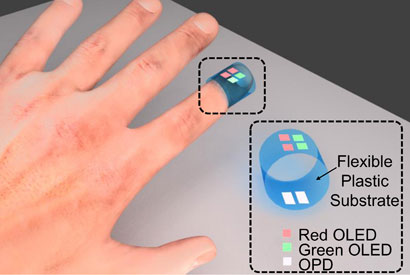Organic electronics could lead to cheap, wearable medical sensors

UC Berkeley engineers have created a pulse oximeter sensor composed of all-organic optoelectronics that uses red and green light. The red and green organic light-emitting diodes (OLED) are detected by the organic photodiode (OPD). The device measures arterial oxygen saturation and heart rate as accurately as conventional, silicon-based pulse oximeters. (Image by Yasser Khan)
“There are various pulse oximeters already on the market that measure pulse rate and blood-oxygen saturation levels, but those devices use rigid conventional electronics, and they are usually fixed to the fingers or earlobe,” said Ana Arias, an associate professor of electrical engineering and computer sciences and head of the UC Berkeley team that is developing a new organic optoelectronic sensor.
By switching from silicon to an organic, or carbon-based, design, the researchers were able to create a device that could ultimately be thin, cheap and flexible enough to be slapped on like a Band-Aid during that jog around the track or hike up the hill.
The engineers put the new prototype up against a conventional pulse oximeter and found that the pulse and oxygen readings were just as accurate.
The research team reported its findings today (Wednesday, Dec. 10) in the journal Nature Communications.
Giving silicon a run for its money
A conventional pulse oximeter typically uses light-emitting diodes (LEDs) to send red and infrared light through a fingertip or earlobe. Sensors detect how much light makes it through to the other side. Bright, oxygen-rich blood absorbs more infrared light, while the darker hues of oxygen-poor blood absorb more red light. The ratio of the two wavelengths reveals how much oxygen is in the blood.
For the organic sensors, Arias and her team of graduate students – Claire Lochner, Yasser Khan and Adrien Pierre – used red and green light, which yield comparable differences to red and infrared when it comes to distinguishing high and low levels of oxygen in the blood.
Using a solution-based processing system, the researchers deposited the green and red organic LEDs and the translucent light detectors onto a flexible piece of plastic. By detecting the pattern of fresh arterial blood flow, the device can calculate a pulse.
“We showed that if you take measurements with different wavelengths, it works, and if you use unconventional semiconductors, it works,” said Arias. “Because organic electronics are flexible, they can easily conform to the body.”
Arias added that because the components of conventional oximeters are relatively expensive, healthcare providers will choose to disinfect them if they become contaminated. In contrast, “organic electronics are cheap enough that they are disposable like a Band-Aid after use,” she said.
The National Science Foundation and Flextech helped support this research.
Media Contact
All latest news from the category: Power and Electrical Engineering
This topic covers issues related to energy generation, conversion, transportation and consumption and how the industry is addressing the challenge of energy efficiency in general.
innovations-report provides in-depth and informative reports and articles on subjects ranging from wind energy, fuel cell technology, solar energy, geothermal energy, petroleum, gas, nuclear engineering, alternative energy and energy efficiency to fusion, hydrogen and superconductor technologies.
Newest articles

A ‘language’ for ML models to predict nanopore properties
A large number of 2D materials like graphene can have nanopores – small holes formed by missing atoms through which foreign substances can pass. The properties of these nanopores dictate many…

Clinically validated, wearable ultrasound patch
… for continuous blood pressure monitoring. A team of researchers at the University of California San Diego has developed a new and improved wearable ultrasound patch for continuous and noninvasive…

A new puzzle piece for string theory research
Dr. Ksenia Fedosova from the Cluster of Excellence Mathematics Münster, along with an international research team, has proven a conjecture in string theory that physicists had proposed regarding certain equations….



